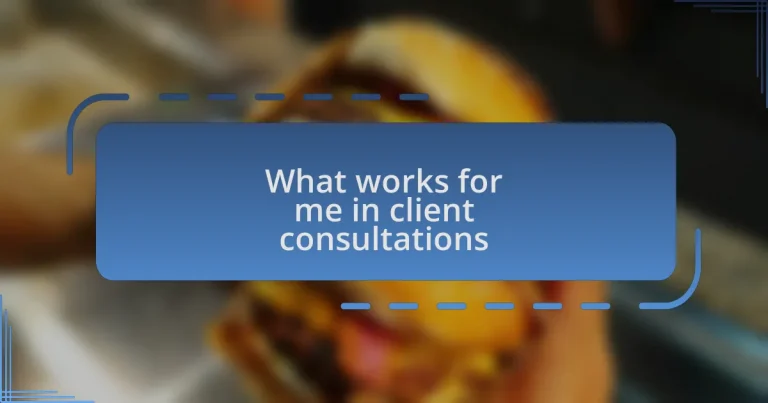Key takeaways:
- Understanding client preferences through active listening enhances the customization of offerings, making food a memorable experience tied to emotions.
- Effective communication prevents misunderstandings and builds trust, reinforcing client relationships and encouraging repeat business.
- Involving clients in the creative process fosters innovation and personal connection, transforming consultations into collaborative culinary experiences.
- Gathering feedback creates opportunities for improvement and sparks new ideas, ensuring that client voices shape the final product.
Author: Olivia Hartwell
Bio: Olivia Hartwell is a contemporary fiction author known for her compelling narratives and vivid characterizations. With a background in literature and creative writing, she has a keen eye for detail and a passion for exploring the complexities of human relationships. Olivia’s debut novel, Whispers of the Heart, received critical acclaim and was nominated for several literary awards. When she’s not writing, she enjoys hiking in the mountains of Colorado and sipping artisanal coffee at local cafes. Olivia resides in Denver with her beloved rescue dog, Rosie.
Understanding client consultations
I’ve always found that understanding client consultations is like peeling an onion—there are layers that reveal deeper insights about client preferences and their expectations. Each session has the potential to uncover not just their desires for the perfect gourmet burger, but also their emotional connections to food. Have you ever noticed how a simple food choice can spark nostalgia?
Listening actively during these consultations is key. One time, a client shared fond memories of summer barbecues, which led us to create a burger that echoed those flavors. It was a reminder that food isn’t merely sustenance; it’s an experience that taps into our emotions and shared moments.
Engaging with clients in an open dialogue fosters trust and encourages them to share more about their vision. Have you ever felt that spark when discussing ideas with a passionate client? That moment when you know you’re on the same wavelength and can craft something truly special together? It’s those exchanges that fuel creativity and innovation in our gourmet offerings.
Importance of effective communication
Effective communication in client consultations is crucial for understanding their needs and desires. For instance, during a recent consultation, a client expressed a love for bold flavors, which led me to suggest a spicy gourmet burger option. That simple conversation not only aligned our vision but also sparked excitement in them—I could see it in their eyes.
Moreover, clarity in communication prevents misunderstandings that can derail the entire process. I recall a situation where a miscommunication about toppings led to a disappointing outcome for a client’s event. By taking the time to clarify their preferences and ensuring we were on the same page, we transformed a potentially awkward moment into a successful, memorable meal.
Building rapport through effective communication can establish lasting relationships. When clients feel heard and valued, they are more likely to return for future events—or recommend us to others. How often do we choose a service based not just on the product, but on that personal connection? It’s those shared moments that create loyal customers who appreciate the artistry behind each burger.
Best practices for engaging clients
Engaging clients requires authenticity in every interaction. I remember a time when I was working on a custom burger for a couple’s anniversary. Instead of simply presenting menu options, I asked them about their favorite memories related to food. Their eyes lit up as they shared a story about a burger they had on their first date. By tapping into their emotions, I was able to create a personalized burger that not only tasted amazing but also had special meaning attached to it.
Another effective approach is to maintain an open dialogue throughout the consultation. I find that asking for feedback during the planning process helps align expectations. In one instance, I offered a few variations of gourmet sauces for a corporate event. By encouraging clients to taste and provide input, not only did they feel more involved, but it also led to a flavor combination that exceeded their expectations. How often do we underestimate the power of involving clients in the creative process?
Lastly, incorporating storytelling into consultations can transform the client experience. When I describe the origins of ingredients or the inspiration behind unique burger creations, I see sparks of curiosity—it’s like we’re sharing a secret. I once recounted the journey of sourcing local grass-fed beef, which not only elevated the burger’s appeal but also connected the client to their meal on a deeper level. Isn’t it fascinating how a simple story can turn a consultation into a memorable experience?
Tailoring menu options for clients
When it comes to tailoring menu options, I always begin by genuinely considering the client’s vision. I remember a wedding planner who wanted a burger menu that reflected the couple’s love for travel. We incorporated international flavors like teriyaki and tzatziki into our offerings. This attention to their personal stories created a menu that felt intimate and special.
In another consultation, a client approached me concerned about dietary restrictions. I listened and tailored our selection to include gluten-free buns and a range of vegan toppings. I could see their relief and excitement when we crafted a gourmet option that worked for everyone. It’s rewarding to see clients light up when they realize their entire guest list can enjoy the food together.
Engaging clients in the discussion of menu options not only boosts their satisfaction but also builds trust. I often ask what flavors or ingredients resonate with them, leading to creative fusions that surprise them. Isn’t it incredible how a simple question can open the door to a burst of creativity? By involving clients in the decision-making process, I feel we create more than just a menu; we craft a shared culinary experience that reflects their unique story.
Gathering feedback during consultations
Gathering feedback during consultations is vital for honing our offerings. I always encourage clients to share their thoughts openly. I remember one client who initially hesitated to voice concerns about spice levels. Once I reassured them it was a collaborative process, they shared their preference for milder flavors, which allowed us to modify a signature dish. Their relief was palpable, and it taught me the importance of creating a safe space for honest dialogue.
I often use feedback as a springboard to discover new ideas. During one session, a client mentioned their childhood memories of backyard barbecues. This inspired me to design a burger infused with smoky flavors reminiscent of those family gatherings. The satisfaction on their face when we finalized that concept was a poignant reminder that feedback can be the spark for extraordinary innovations.
Additionally, I like to implement a quick survey at the end of consultations, asking for reflections on our discussion. This not only shows clients that their input is valuable but also creates a platform for continuous improvement. I often wonder how many unique dishes we’ve developed simply because someone dared to share their preference. Doesn’t that make each collaboration feel impactful? It reinforces my belief that every voice matters in crafting memorable culinary experiences.
Tips for successful client interactions
Client interactions thrive on genuine connection. I’ve learned that when I approach each consultation with a listening ear and an open heart, it fosters a sense of trust. For example, during a recent consultation, a couple shared their passion for local ingredients. Their enthusiasm inspired me to highlight seasonal produce in our burger creations, reinforcing that their insights not only matter but also enhance our menu. How can we tap into our clients’ passions if we don’t first take the time to listen?
Being transparent about my process can also enrich client dialogues. I once explained the sourcing of our ingredients to a potential client who was curious about food quality. As I shared stories of local farmers and the journey from farm to truck, I noticed their appreciation deepen. It’s moments like these that underline the importance of storytelling in building relationships. Isn’t it fascinating how a simple conversation can transform client expectations into genuine excitement?
Finally, maintaining a flexible mindset during consultations is crucial. I remember a session where a client suggested mixing flavors I had never paired before. Instead of dismissing the idea, I embraced it, leading us to a bold, new burger idea that became a favorite. This adaptability often cultivates a collaborative atmosphere, prompting clients to feel more engaged and invested. After all, who doesn’t want to be a part of something innovative?


